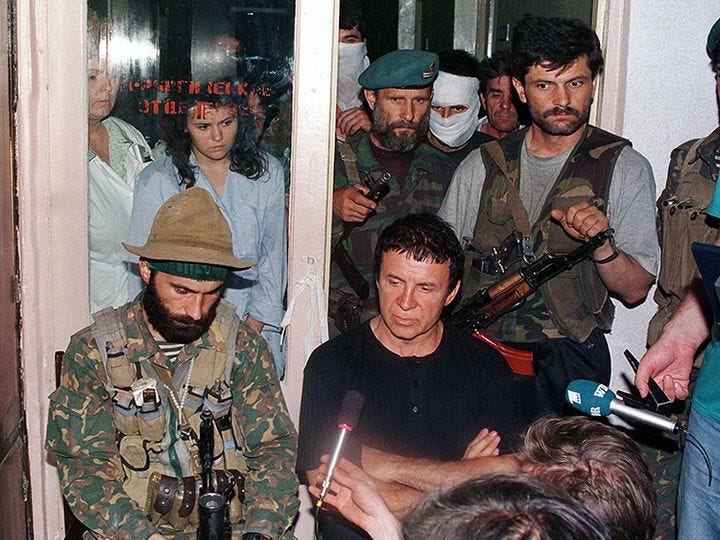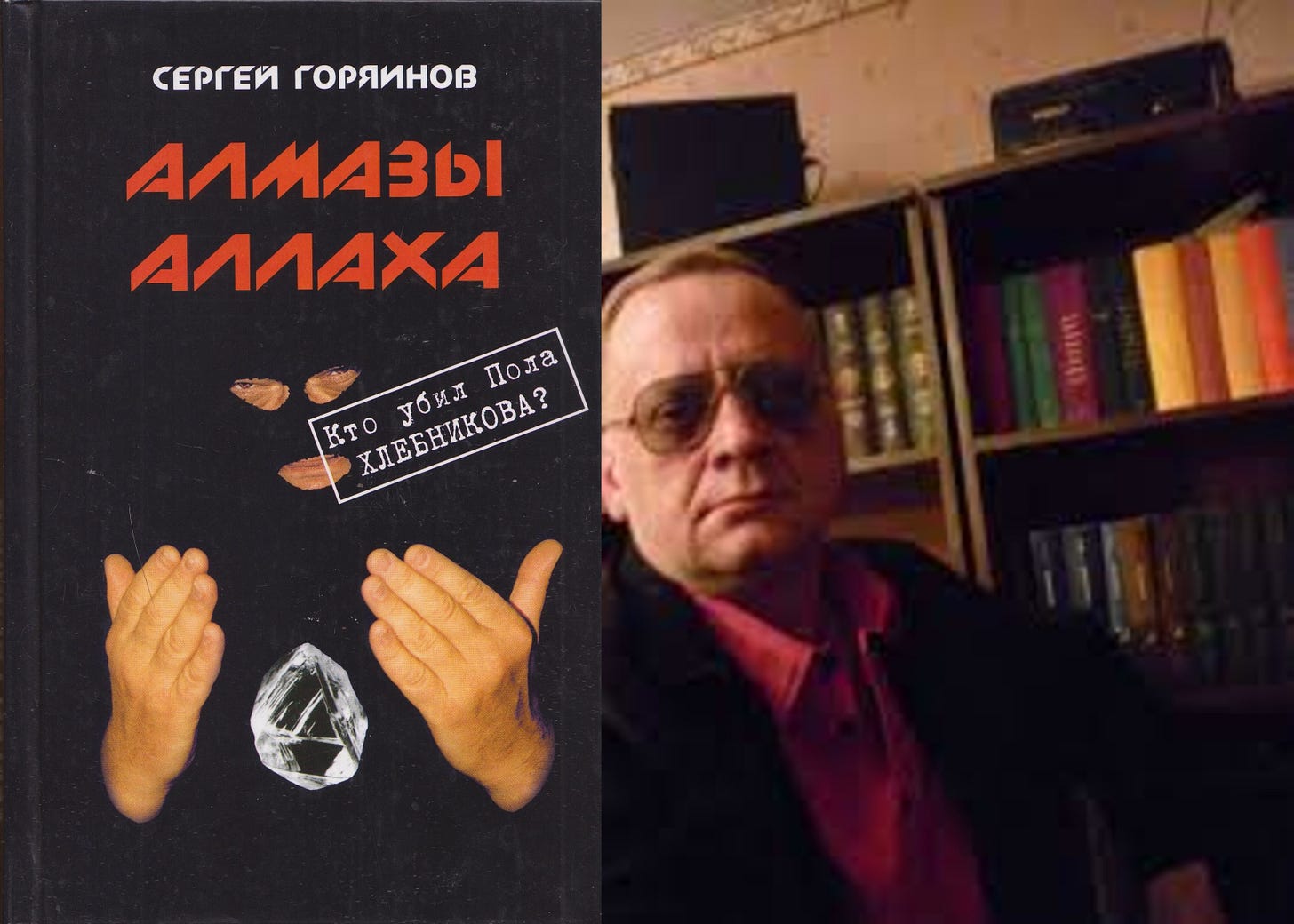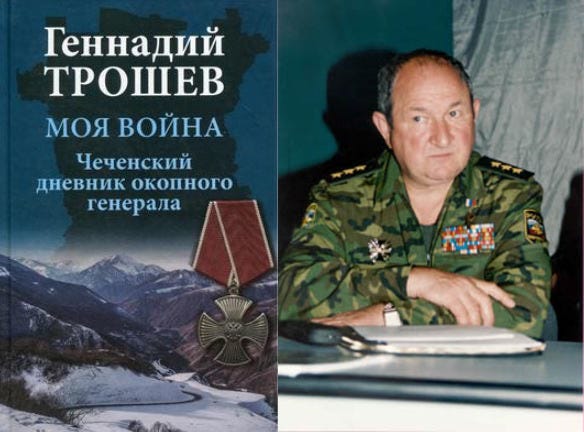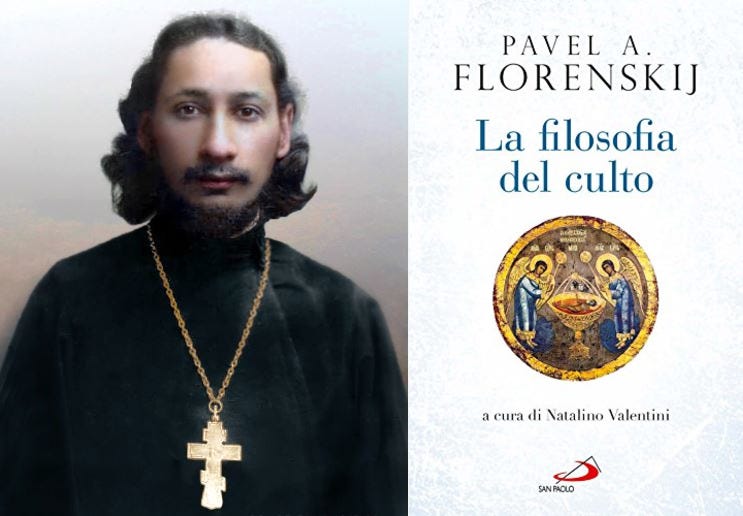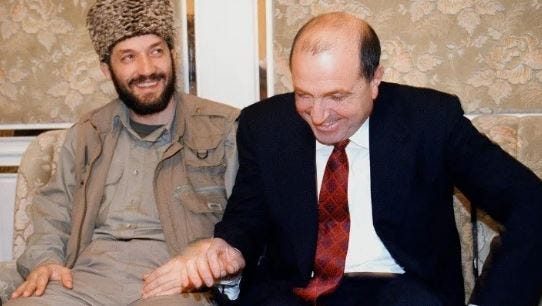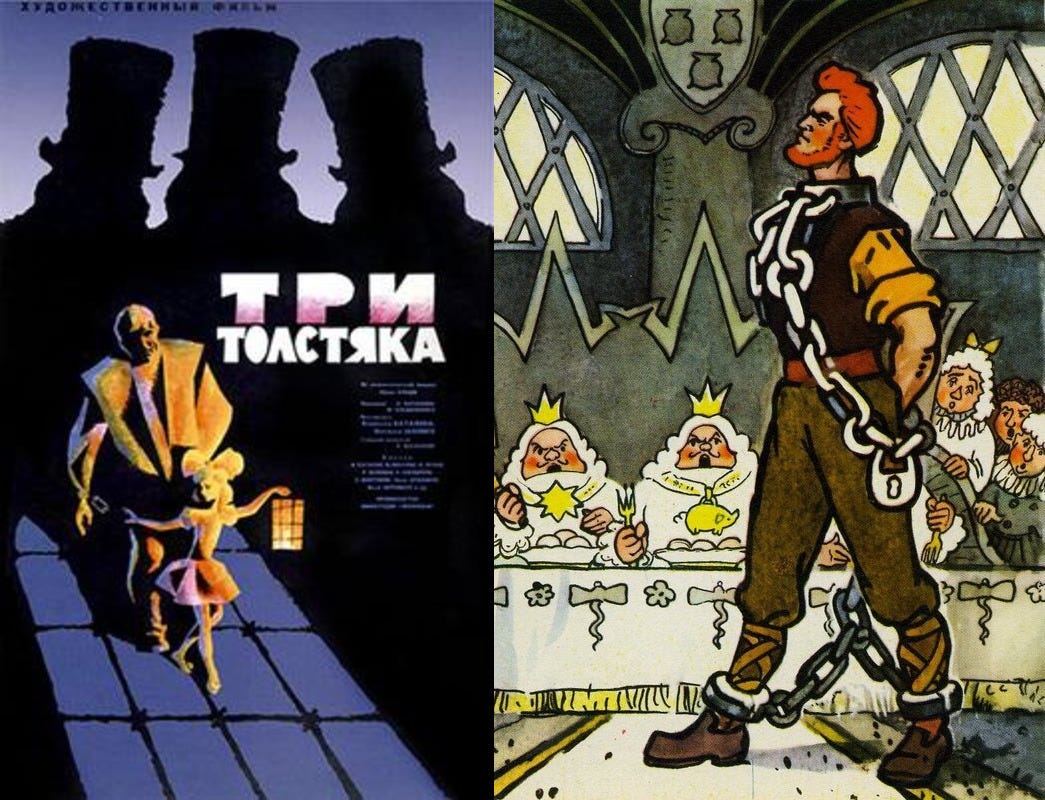Ritual War: Occult Terror
Chapters VIII, IX and X
Before delving into the forthcoming chapters, readers are strongly encouraged to familiarize themselves with the earlier chapters of Ritual War by Nicholas Kozlov, translated and published on the WorldWarNow Substack. Chapters One through Seven lay the essential groundwork for understanding the intricate themes that follow.
The previous release, Chapters Six and Seven, examines the traditions of enigmatic tribes in the Northern Caucasus, set against the backdrop of the Russo-Chechen conflicts.
Chapter VIII: The Bitterness of Beslan
The development of black political technologies, which utilize ritual murders and mass terrorist acts as instruments for manipulating public consciousness and the biogenetic life of peoples, is a component of a unified Kabbalistic plan aimed at enthroning a universal monarchy under a Jewish king - the Moschiach.
In the Protocols of the Elders of Zion, discovered and published over a century ago, the incitement of mutual hatred among peoples, murder, and terror - under the dictate of controlled media - are proclaimed as principal means for the establishment of global Talmudic hegemony.
To anyone familiar with the misanthropic prescriptions of the Talmud, which encourage boundless deceit and cunning in relations between Jews and goyim, and which advocate the shrewd subordination and utilization of governmental and societal institutions by the Jewish kahal to achieve global domination, it becomes evident that mass ritual killings (so-called terrorist attacks) such as those in Budyonnovsk, Nord-Ost, and Beslan are nothing other than joint operations of corrupt intelligence services, law enforcement agencies, and Jewish-controlled media that promote international terrorism (including ‘Chechen terrorism’) to instill fear and suppress non-Jews. Without the covert complicity of the Jewish kahal - disguised as political regulation - and the cooperation of intelligence services, such acts would be impossible.
Article 17 of the Criminal Code of the Russian Federation states:
“Complicity is defined as the intentional joint participation of two or more individuals in the commission of a crime. Alongside perpetrators, organizers, instigators, and accomplices are also recognized as participants.
The perpetrator is the one who directly commits the crime.
The organizer is the one who arranges or directs the commission of the crime.
The instigator is one who incites another to commit the crime.
The accomplice is the one who assists in the crime through advice, instructions, provision of tools, or removal of obstacles, and also one who promises in advance to conceal the offender, tools, traces of the crime, or objects obtained through criminal means. The degree and nature of each participant’s involvement must be considered by the court when imposing punishment.”
The commentary to Article 17 emphasizes:
11. An instigator is one who causes another person to form the intent to commit a crime -via persuasion, requests, bribery, threats, etc. Instigation includes not only leading the perpetrator but also other participants. A person who incites a minor or someone legally incompetent is not considered an instigator but a direct perpetrator. In such cases, the minor or incompetent acts as a kind of instrument, and the instigator bears full responsibility as the executor of the socially dangerous act.
12. An accomplice is someone who aids the commission of a crime. Assistance may be intellectual - advice, instructions, or information (e.g., informing about the absence of homeowners for a planned burglary) - or physical - providing tools, disabling alarms, standing guard, etc. Intellectual complicity involves actions. Physical complicity may involve actions or inactions.
Since the law does not provide for any form of justice outside the criminal procedural framework, it is evident that in cases of mass ritual killings involving the capture and detention of hostages, any unauthorized influence on the course of the crime - such as media broadcasts of events, negotiations, partial concessions to terrorists’ demands (including voluntarily offering oneself as a hostage) - must be legally classified as complicity.
By establishing, through its agents in government, intelligence, law enforcement, media, medical institutions, and public organizations, unauthorized contact with perpetrators at the time of the crime - negotiations over partial releases, provision of medical or psychological aid, media support of terrorist demands - the Jewish kahal substitutes itself for lawful authorities and embeds into public consciousness a system of relationships above the law, founded upon the presumption of the supreme value of the Talmudic community. This is termed blat (In Russian the word means ‘Profanity’ or ‘Curses’; from Yiddish ‘blat’ - palm, implying handshake deals, mutual cover-ups, distinct from herem - excommunication or curse). Out of this comes the popular Soviet saying: “Blat is above the Sovnarkom.”
The appearance of blat-associated figures like Anatoly Kashpirovsky, Kobzon, and Doctor Roshal at hostage negotiations lends these events the character of turf wars between Russo-Jewish and Chechen-Jewish clans (Russian and Caucasian Jews), which the international kahal uses to develop and test supranational administrative institutions.
According to a Jewish source, the mission of Kashpirovsky - a black magician, occultist, and Duma deputy - in Budyonnovsk is portrayed as an oddity:
“In the office, Kashpirovsky immediately sat opposite Basayev and began staring into his face. It appeared that the psychic was trying to hypnotize the gang leader. Big Aslanbek, sitting nearby, nudged me and asked Kashpirovsky:
‘Well, Anatoly Mikhailovich, is it working?’
‘No, it’s not.’
Basayev seemed confident, though visibly nervous. After the negotiations, we began to leave the hospital. Kashpirovsky stayed behind. One group member approached me and asked me to tell the psychic to leave too.
I approached Kashpirovsky. It was clear that his failed attempt to hypnotize Basayev had upset him deeply.
‘Anatoly Mikhailovich, are you staying or leaving?’
At that moment, women burst into the room.
‘Anatoly Mikhailovich, stay with us!’
Kashpirovsky immediately straightened and said: ‘I will not leave until the last hostage has left!’
I asked him again, and he firmly repeated that he would not leave and remained in the office.”
(Topol, pp. 84–85)
Kashpirovsky’s actions - potentially subject to legal scrutiny under Article 17 - were shielded by parliamentary immunity, which typically protects kahal-related agitation around Jewish criminal projects.
The allegedly ‘anti-Semitic’ character of Chechen or broader Islamic and Semitic opposition appears superficial or ‘domestic.’ This is evidenced by the lack of strong responses from Talmudic communities - even in cases involving the kidnapping of Jewish hostages. Despite declarations such as that by Arbi Baraev, who threatened to kill any Jews he captured, and some reported brutalities toward Jewish hostages, the overall reaction of the Talmudic community has remained neutral.
It can be assumed that these are internal conflicts between Caucasian and European Jewish clans, or part of a sophisticated PR campaign designed to obscure the Talmudic underpinnings of the Chechen war. A knowledgeable researcher of the North Caucasus conflict writes:
“Since pro-Chechen sympathies outweighed feelings of Jewish solidarity or human rights principles, no significant efforts were made by Jewish or human rights organizations to protect Jewish hostages or to condemn antisemitism in Chechnya. The exact number of Jews who suffered from robbery, murder, or abduction in Chechnya is difficult to establish. E.L. Gelman assured me that no Jews remain in Chechnya today.”
(Valery Tishkov, ‘Selected Works’, p. 403)
It is evident that reference here is made to ‘passport Jews’ - the Ashkenazim. One can easily imagine the reaction of the Talmudic community if similar expressions of ‘anti-Semitism’ had originated from Orthodox Christian or ethnically Russian environments.
A serious blow to the camouflage of antisemitism among Chechen bandits was dealt by the invitation extended by the ‘antisemite’ Baraev to Deputy Kobzon for negotiations at Dubrovka-Kobzon being someone whose connections with the criminal underworld (particularly in the early release of the criminal authority Vyacheslav Ivankov, known as ‘Little Japanese’ from the Tulun prison and his subsequent departure to the United States) had already become a matter of public record.
Turko-Khazar Judaism, having undergone mimicry within the Muslim world of the Caucasus in the form of Sufi-Kabbalistic sects - unlike the Europeanized Hasidism - is the shared spiritual-genetic root of modern polyethnic Jewry. This root connects an English film star and a bandit hiding from Russian justice in the mountains, a famous Jewish singer and a terrorist-’antisemite.’
“Therefore, the radical Islamist Khozh-Akhmed Nukhayev (a Chechen bandit and head of foreign intelligence under the Chechen Jew Dzhokhar Dudayev) quite justly sees no distinction between Hasidim and Chechens.”
- Sergey Goryainov, The Diamonds of Allah, Moscow, 2004, p. 155.
The Kabbalistic practice of ritual murder as an instrument for altering the genetic destiny of humanity - aimed at the triumph of the dregs of the Hamito-Semitic race over the chosen people - historically unites Caucasian Muridism and Eastern European Hasidism into a single militant anti-Christian criminal community, founded on the principle of collective blood vengeance against anyone who threatens any of its members.
The Kabbalistic practice of ritual murder as a tool for altering the genetic destinies of humanity - directed toward the triumph of the dregs of the Hamito-Semitic race over the chosen people - historically unites Caucasian Muridism and Eastern European Hasidism into a single militant anti-Christian criminal community, built on the principle of collective blood vengeance against anyone who threatens one of its members.
The Talmud states that any goy who kills a Jew, insults him, or steals from him ‘less than a prutah’ is deserving of death. The Old Testament principle of equivalent retribution (‘an eye for an eye and a tooth for a tooth’) applies only to members of the Talmudic community. When avenging the blood of a ‘Jew,’ the stakes are increased manifold, as shown by the practice during the Russian Civil War, when dozens or even hundreds of hostages were executed in response to the killing of a single commissar. In the case of the murder of Moisei Uritsky, the head of the Petrograd Cheka, by the Jewish Leonid Kannegisser, mass executions were carried out against residents of all classes in the city.
The revolutionary practice of mass execution of hostages (who were not directly responsible for the killing being avenged) finds an unexpected continuity in the actions of ‘Chechen shahids in Budyonnovsk, Pervomaysk, and Beslan - events that, according to the author, can only be explained as a form of Talmudic revenge for the killing of a ‘blatnoy’ (criminally connected) Chechen-Jew.
But what object of blood vengeance could be more symbolically valuable than the life of a child? When Eastern European Hasidim in the 18th–19th centuries sought to establish themselves in a given locality and suppress the spirit of resistance among local Christians, they allegedly bribed the police, kidnapped a Christian child, kept him imprisoned while his family searched in vain, performed a ritual murder, and then discarded the body like refuse.
By putting forward deliberately unacceptable demands during hostage crises, Chechen shahids provoke mass ritual killings, intended to instill a sense of hopelessness in Christians - comparable to the despair felt by parents of a kidnapped child, awaiting a torturous death in a Jewish dungeon. The demand to end the war in Chechnya was merely a cover for the terrorists’ true goal: the suppression of the Russian people’s spirit - the ‘restraining force’ (Katechon) that holds the world back from destruction in the last days. This was to be achieved through mass ritual killings, or in theological terms, blood sacrifices.
The most sinister role in the criminal alliance of ‘thieves-in-law,’ human rights defenders who harbor them, and false-witness journalists is played by an organization that stands above the law - its character, sphere, and methods of operation classified as a state secret. The well-known secret is that the organization, originally intended to carry out occult-terrorist functions in defense of the state, turns its weapon against the state itself.
Having emerged from the Jewish occult-terrorist underground and seized the functions of state security in 1917, the Cheka–GPU–NKVD–KGB–FSB has now, for nearly a century, waged an unceasing war against the Russian people in the interests of international Jewry. With one hand fueling the engine of terrorism and with the other restraining it, this organization plays the part of a hapless snake-charmer whose serpents, slithering away, bite the spectators. It attempts - through Kabbalistic techniques - to bring under control the “lust for murder” (John 8:44: “You are of your father the devil, and the desires of your father you want to do. He was a murderer from the beginning…”), this “energy of Satan” (2 Thessalonians 2:9: “The coming of the lawless one is according to the working of Satan, with all power, signs, and lying wonders”), i.e., to govern the devil himself.
One may understand the psychological motives that drive suicide bombers (shahids) to take hostages or carry out terrorist attacks, but how are those trained who are capable, under orders from the kahal, of marching military units through the epicenter of a nuclear blast, staging the Chernobyl disaster, blowing up residential buildings in Moscow, or preparing an explosion in Ryazan? Who orchestrate the creation of an escape corridor and cover for fleeing militants in Pervomaysk, or burn with flamethrowers the bodies bearing signs of ritual torture in Beslan? These are acts rooted in the man-hating secrets of the Talmud.
Chechen banditry - and Muslim shahidism in particular - has deep historical roots in the tradition of abrechestvo, which has existed in the Caucasus since ancient times. Its primary characteristic, as noted by ethnographic researchers, is a rupture with the norms of the social order, a cursing or consecration of the individual to demonic forces, to the lust for murder. Semantically, the word abrek (from ibri - ‘foreigner’ or ‘robber’) implies the sacralization of banditry, elevating it into a cult of killing.
The cultic nature of abrechestvo, which is fundamentally based on a sacralized “feeling of revenge against everyone and everything” (Yuri Botyakov, ‘Abreks in the Caucasus’, St. Petersburg, 2004, p. 132.), allows us to consider the historically entrenched custom of blood vengeance in the Caucasus as a specific form of the evolution of ancient human sacrifice practices. Modern Chechen shahidism may be viewed as one of the operational ethnic divisions of a blood-soaked cult of murder under the control of an international Kabbalistic hierarchy.
The expression ‘Chechen shahids’ is tautological, since both words derive from the same Semitic root - shekhet, meaning ‘to kill.’ Chechnya and the Chechens take their name from a mountainous region and its inhabitants, whose main occupations for centuries have been killing, violence, and robbery. The name Chechnya, known since the 19th century, refers to a union of Vainakh tribal clans - teips (self-designation: nokhchi) - descendants of the ancient Khazars, led by an elite Talmudic mountain Jewish nobility assimilated into local Caucasian traditions. Alongside blood vengeance, the consumption of the flesh and blood of slain enemies was an ancient military-magical custom of the Chechen highlands, reflected in the regional epic tradition (Botyakov, pp. 102, 115).
An interesting etymological comparison follows:
chechenit’sya – to act coy, to feign;
chikat’ – to push, to stab;
shikat’sya – to copulate;
chechen’ – a spoiled or pampered child;
chechenya – a dandy;
sheikh, shah – tribal leader, king;
chechak or shishak – helmet;
shish – bandit, vagrant;
shishka – gang leader (Max Vasmer, Etymological dictionary of the Russian language).
Also notable is the obscenely suggestive meaning of this etymological sequence, especially as it relates to the phrase ‘to hold the shishka’ - meaning to hold dominance or ignite charisma. The ancient meaning of the name Ichkeria might be derived from the component words ‘ich’ and ‘ker’ - signifying the female and male genital organs, respectively. This interpretation finds semantic correspondence in the sacred architecture of Chechnya and Ingushetia, which bears a distinct mark of a phallic cult. Such are the famous clan towers of Chechnya, dedicated to the solar deity ‘Dela Molkh’ (possibly the Moloch of the ancient Hebrews?) and the underworld deity Eshtro (possibly Astarte, the goddess of war and death?). The family name of the high priest of the Ingush, mentioned by Bashir Dolgat - Phalkhanov (interpreted as ‘priest of Baal’ or Phal) - has Semitic roots and constitutes a direct reference to the Semito-Hamitic phallic cult (Bashir Dolgat, The Primitive Religion of the Chechens and Ingush, Moscow, 2004, p. 31).
"Since ancient times, ritual killings or human sacrifices have served as a powerful means of influencing the human psyche.
The Bible recounts how, during the siege of Kir Haraseth by the Israelite army, the king of Moab offered his eldest son as a burnt offering on the city wall in full view of the Israelites, and they withdrew in horror. As it is written:
“Then he took his eldest son who would have reigned in his place, and offered him as a burnt offering upon the wall. And there was great indignation against Israel. So they departed from him and returned to their own land.”
- 2 Kings 3:27
Having adopted the practice of human sacrifice along with the cult of Baal-worship from surrounding nations, the Jews burned both their own and foreign children near Jerusalem in the Valley of Hinnom (Gehenna), in a place called Tophet. The priests performing these sacrifices were divided into two ranks: one carried out the physical labor of slaughtering and burning the victims, while the other, through incantatory chanting and playing of tambourines, intensified the accumulated energy of horror and despair in that place, calling down curses upon the enemies of Israel.
The channeling or transference of suffering and pain from one person to another is, evidently, the core concept of religious sacrifice. In Christianity, this is expressed in the atonement of humanity’s sins and suffering by Jesus Christ—repeated each time in the Bloodless Sacrifice. In the bloody cults of antiquity and even of the present day, the sacrifice is substitutionary - “from a sick head to a healthy one.”
Video recordings of executions and torture carried out by Chechen bandits appear, evidently, to be well-compensated “field material,” gathered for secret Kabbalistic research or cultic centers.
Scenes such as the flaying of a living Russian military sergeant in Budyonnovsk, or the torture of a woman in labor in Kizlyar—filmed on orders from the international kahal, which allegedly conducts strategic and tactical coordination of military actions in the North Caucasus - generate, at the moment of retransmission, the effect of magical participation. This effect is said to channel the energy of the victim’s dying agony into the current of a Kabbalistic ritual. These actions become a transformed substance of operative magic, ‘coming to life’ in the hands of hierarchically high-ranking, ‘cabinet-level’ Kabbalists.
General Gennady Troshev, in his book “My War”, writes:
“Khattab simply adores, as do some of his comrades, public executions - especially of non-believers. Slowly cutting off the ears, noses of prisoners, scalping them (...). And ensuring that everything is recorded on video. These ‘film documents’ he then shows to influential foreign Muslim ultras to demonstrate his firm commitment to the creation of a new Wahhabi state - from the Caspian to the Black Sea.
Likewise, a Jordanian Chechen demands that all operations and terrorist acts personally carried out by him be recorded on video. He is constantly accompanied by two cameramen. Among Khattab’s most well-known operations are: the terrorist attack in Budyonnovsk (70 militants from Khattab’s unit took part, and all survived), securing a ‘corridor’ for Raduyev’s gang near the village of Pervomayskoye, the ambush and massacre of the 245th regiment’s convoy near the village of Yaryshmardy, the ambush at Serzhen-Yurt, and the attack on motorized rifle troops in Buynaksk (where he was wounded in the shoulder). These documentary recordings were sold to foreign TV companies for enormous sums. In all of them, the Black Arab shamelessly demonstrates his personal successes in firearms, explosives, and torture.”
(Troshev, p. 229)
Modern Chechnya is a place where, at the state level, ritual animal sacrifices are legalized in connection with official dates. For example, ritual sacrifices in memory of those killed in Budyonnovsk were performed in the village of Novogroznenskoye on June 14, 1997 (Topol, p. 7).
But the blood of sacrificial animals, as known from the history of religion, is only a lower form - a substitute for human sacrifice. And as Father Pavel Florensky writes:
“If this (bloody animal sacrifice) is frightening - then how much more terrifying are pagan cults with their human sacrifices: throwing children into the red-hot bowels of idols, slaughtering, tearing out the heart from a living person (as in Mexico), sacred tortures, and the like.”
(Pavel Florensky, Philosophy of Cult, p. 45)
The roles of the priestly timpanists in the modern bloody cult, through which the new servants of Baal intend to rule the world by channeling the energy of terror -invoked through ‘international terrorism’ against all those inconvenient to the new world government - are, without doubt, distributed among key figures in contemporary political technologies and mass media.
The public appeals made during press conferences amid hostage crises and mass ritual killings - such as “let’s not over-publicize this topic” - clearly do not apply to them.
One such figure is Boris Abramovich Berezovsky - during the ‘Soviet’ era, a Doctor of Physical and Mathematical Sciences, a corresponding member of the Academy of Sciences, and a staff member at the Institute for Control Problems of the Academy of Sciences. Under the guise of this institute, cadres were trained for the Soviet Kabbalistic school, which contributed to the theory and practice of ‘managed conflict.’
It is believed that Berezovsky, as a Kabbalist of high initiation, due to his position as manager of kahal finances, head of the largest media holding, and his government post as Deputy Secretary of the Security Council, became the “flesh-bearing demon” of the Chechen war - within whose hands were concentrated the actual levers of control over the military conflict in the North Caucasus.
Berezovsky controlled the kahal’s funding of Chechen banditry, organized the release of especially dangerous Chechen bandits from Russian prisons by exchanging them for Russian hostages - whose capture was instigated specifically to achieve this criminal aim by prior conspiracy (Kirill Belyaninov, The Gentlemen with Hexogen, Moscow, 2003).
The method of ‘managed conflict’, used by intelligence services, involves creating an aggressive environment through the artificial organization of a tense, illusory confrontation, and then drawing in (or pushing out) a targeted object for subsequent active development (or suppression).
The system of hostage exchanges and ransoms created by Berezovsky, with the direct involvement of intelligence services - some of whom were infiltrators, recruited from journalists and FSB officers - was, like the entire Chechen war itself, a classic example of ‘managed conflict.’ It was aimed at transforming public consciousness by forming a socially-sanctioned, aggressive, lawless environment - necessary for exerting pressure on ‘development targets’ falling within the criminal interests of the international kaрal.
By amplifying the shame, bitterness, and pain of Budyonnovsk, Nord-Ost, and Beslan, the media - which long ago ceased to be mere observers and witnesses - alongside occult-terrorist and Chekist underground networks, are actively shaping a false reality that looms over the world like a terrible threat. They conjure the phantom of terrorism (terror — Latin: ‘fear’) over Russia, provoking a response of either hatred or fear among people not yet transformed into a submissive, sacrificial herd heading to the Talmudic slaughterhouse.
Especially blasphemous is the method of Jewish counter-propaganda, which attempts to profane the topic of mass terror and ritual murder by turning it into a joke. There are intriguing theories about who created the dark humor surrounding Chernobyl, or who engineers the cannibalistic media mainstream.
Typically, the media first releases a string of stories about world pop stars - renowned for their eccentricities - who dabble in Jewish Kabbalah. These stories appear alongside reports of household cannibalism committed by so-called lone maniacs. Then comes an article titled ‘The Kabbalist Turned Out to Be a Cannibal’, describing how the singer Makarevich, known for his interest in Kabbalah, supposedly jokes - or perhaps seriously muses - about wanting to taste human flesh. In this way, Talmudic sages turn a forbidden and grim subject into farce in the public mind.
The vast tactical capacity for information warfare wielded by Jewish special propaganda is revealed in a PR campaign conducted during the trial of Colonel Budanov in Rostov-on-Don. At that time, billboards appeared advertising the beer ‘Three Fat Men’ with the slogan: ‘Freedom for a real man,’ above an image of clenched fists breaking chains - a parody of protest posters outside the regional courthouse that played on the theme of ‘male solidarity.’
On an associative level, this messaging carried coded meaning. Just as Prospero, the gunsmith from Three Fat Men, broke free from prison chains and became the leader of a rebel movement, so too could Colonel Budanov and others like him - ‘real men’ in the Armed Forces - pose a threat to the modern ‘fat men’ who launched the Chechen war to suppress the Russian people.
Chapter X: Occult Terror
Today, the words of the well-known Israeli critic of Judaism, Israel Shahak, regarding the role of Talmudic doctrine in the modern political life of Israel, can be fully applied to Russia:




